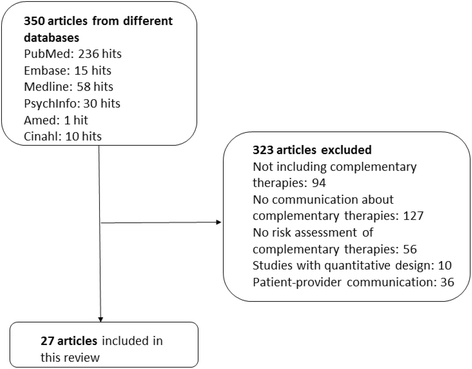Perception of risk and communication among conventional and complementary health care providers involving cancer patients' use of complementary therapies: a literature review
- PMID: 27609097
- PMCID: PMC5016861
- DOI: 10.1186/s12906-016-1326-3
Perception of risk and communication among conventional and complementary health care providers involving cancer patients' use of complementary therapies: a literature review
Abstract
Background: Communication between different health care providers (conventional and complementary) and cancer patients about their use of complementary therapies affects the health and safety of the patients. The aim of this study was to examine the qualitative research literature on the perception of and communication about the risk of complementary therapies between different health care providers and cancer patients.
Methods: Systematic searches in six medical databases covering literature from 2000 to 2015 were performed. The studies were accessed according to the level of evidence and summarized into different risk situations. Qualitative content analysis was used to analyze the text data, and the codes were defined before and during the data analysis.
Results: Twenty-nine papers were included in the primary analysis and five main themes were identified and discussed. The main risk situations identified were 1. Differences in treatment concepts and philosophical values among complementary and conventional health care providers. 2. Adverse effects from complementary products and herbs due to their contamination/toxicity and interactions with conventional cancer treatment. 3. Health care physicians and oncologists find it difficult to recommend many complementary modalities due to the lack of scientific evidence for their effect. 4. Lack of knowledge and information about complementary and conventional cancer treatments among different health care providers.
Conclusion: The risk of consuming herbs and products containing high level of toxins is a considerable threat to patient safety (direct risk). At the same time, the lack of scientific evidence of effect for many complementary therapies and differences in treatment philosophy among complementary and conventional health care providers potentially hinder effective communication about these threats with mutual patients (indirect risk). As such, indirect risk may pose an additional risk to patients who want to combine complementary therapies with conventional treatment in cancer care. Health care providers who care for cancer patients should be aware of these risks.
Keywords: Cancer care; Communication between health care providers; Complementary and Alternative Medicine; Complementary therapy; Oncology; Patient safety; Provider-patient communication; Risk.
Similar articles
-
Attitudes and knowledge about direct and indirect risks among conventional and complementary health care providers in cancer care.BMC Complement Altern Med. 2018 Jan 31;18(1):44. doi: 10.1186/s12906-018-2106-z. BMC Complement Altern Med. 2018. PMID: 29386005 Free PMC article.
-
Complementary and conventional providers in cancer care: experience of communication with patients and steps to improve communication with other providers.BMC Complement Altern Med. 2017 Jun 8;17(1):301. doi: 10.1186/s12906-017-1814-0. BMC Complement Altern Med. 2017. PMID: 28595577 Free PMC article.
-
Communication and information about complementary medicine in a Dutch oncology setting: Interviewing patients and providers on their experiences and needs.Complement Ther Clin Pract. 2024 Nov;57:101916. doi: 10.1016/j.ctcp.2024.101916. Epub 2024 Oct 9. Complement Ther Clin Pract. 2024. PMID: 39405598
-
Complementary therapies and cancer care: an overview.Patient Educ Couns. 1999 Oct;38(2):93-100. doi: 10.1016/s0738-3991(99)00056-7. Patient Educ Couns. 1999. PMID: 14528701 Review.
-
Safety of Complementary and Alternative Medicine (CAM) treatment among children and young adults who suffer from adverse effects of conventional cancer treatment: A systematic review.Integr Cancer Ther. 2022 Jan-Dec;21:15347354221105563. doi: 10.1177/15347354221105563. Integr Cancer Ther. 2022. PMID: 35726681 Free PMC article.
Cited by
-
Integrative oncology and complementary medicine cancer services in Australia: findings from a national cross-sectional survey.BMC Complement Altern Med. 2018 Oct 29;18(1):289. doi: 10.1186/s12906-018-2357-8. BMC Complement Altern Med. 2018. PMID: 30373631 Free PMC article.
-
Chronic Inflammatory Diseases and Green Tea Polyphenols.Nutrients. 2017 Jun 1;9(6):561. doi: 10.3390/nu9060561. Nutrients. 2017. PMID: 28587181 Free PMC article. Review.
-
Education about complementary and alternative medicine in cancer self-help groups by trained peers.BMC Complement Med Ther. 2024 Oct 19;24(1):373. doi: 10.1186/s12906-024-04680-2. BMC Complement Med Ther. 2024. PMID: 39427169 Free PMC article.
-
A Survey on the Prescribing Orientation Towards Complementary Therapies Among Oncologists in Italy: Symptoms and Unmet Patient Needs.In Vivo. 2025 Mar-Apr;39(2):1000-1008. doi: 10.21873/invivo.13905. In Vivo. 2025. PMID: 40010972 Free PMC article.
-
The Effects of Foot Reflexology on Chemotherapy-Induced Nausea and Vomiting in Patients with Digestive System or Lung Cancer: Protocol for a Randomized Controlled Trial.JMIR Res Protoc. 2020 Jul 14;9(7):e17232. doi: 10.2196/17232. JMIR Res Protoc. 2020. PMID: 32449505 Free PMC article.
References
-
- Fønnebø V. Practitioners of complementary and alternative medicine should value their strengths. Focus Altern Complement Ther. 2015;20:102–3. doi: 10.1111/fct.12175. - DOI
-
- LOV-2003-06-27-64 Lov om alternativ behandling av sykdom mv; English Act relating to the alternative treatment of disease, illness, etc, Helse- og omsorgsdepartementet, 2002-2003 Sess. (2003).
-
- Stub T. Safety of Treatment Provided by Homeopaths - Homeopathic Aggravations, Adverse Effects and Risk Assessment. Tromsø: UiT The Arctic University of Norway, Tromsø; 2013.
Publication types
MeSH terms
LinkOut - more resources
Full Text Sources
Other Literature Sources
Medical
Research Materials


